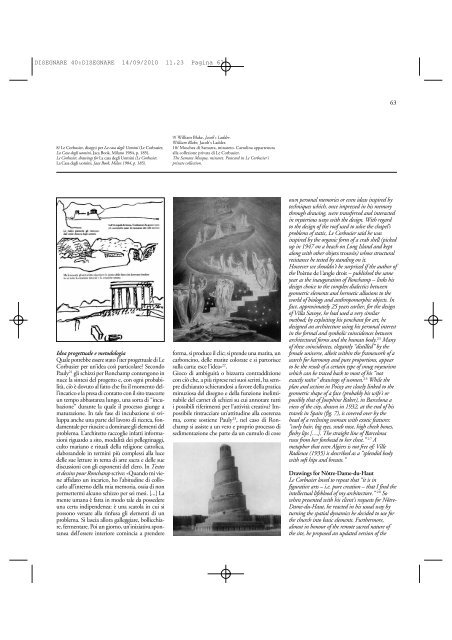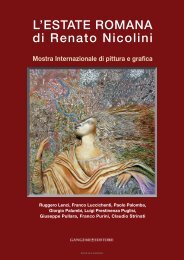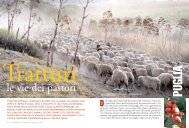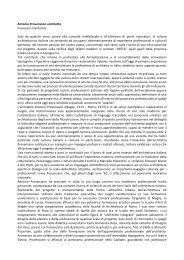Recondite Armonie - Archiwatch
Recondite Armonie - Archiwatch
Recondite Armonie - Archiwatch
Create successful ePaper yourself
Turn your PDF publications into a flip-book with our unique Google optimized e-Paper software.
DISEGNARE 40:DISEGNARE 14/09/2010 11.23 Pagina 63<br />
63<br />
8/ Le Corbusier, disegni per La casa degli Uomini (Le Corbusier,<br />
La Casa degli uomini, Jaca Book, Milano 1984, p. 185).<br />
Le Corbusier, drawings for La casa degli Uomini (Le Corbusier,<br />
La Casa degli uomini, Jaca Book, Milan 1984, p. 185).<br />
9/ William Blake, Jacob’s Ladder.<br />
William Blake, Jacob’s Ladder.<br />
10/ Moschea di Samarra, minareto. Cartolina appartenuta<br />
alla collezione privata di Le Corbusier.<br />
The Samara Mosque, minaret. Postcard in Le Corbusier’s<br />
private collection.<br />
Idea progettuale e metodologia<br />
Quale potrebbe essere stato l’iter progettuale di Le<br />
Corbusier per un’idea così particolare? Secondo<br />
Pauly 21 gli schizzi per Ronchamp contengono in<br />
nuce la sintesi del progetto e, con ogni probabilità,<br />
ciò è dovuto al fatto che fra il momento dell’incarico<br />
e la presa di contatto con il sito trascorre<br />
un tempo abbastanza lungo, una sorta di “incubazione”<br />
durante la quale il processo giunge a<br />
maturazione. In tale fase di incubazione si sviluppa<br />
anche una parte del lavoro di ricerca, fondamentale<br />
per riuscire a dominare gli elementi del<br />
problema. L’architetto raccoglie infatti informazioni<br />
riguardo a sito, modalità dei pellegrinaggi,<br />
culto mariano e rituali della religione cattolica,<br />
elaborandole in termini più complessi alla luce<br />
delle sue letture in tema di arte sacra e delle sue<br />
discussioni con gli esponenti del clero. In Textes<br />
et dessins pour Ronchamp scrive: «Quando mi viene<br />
affidato un incarico, ho l’abitudine di collocarlo<br />
all’interno della mia memoria, ossia di non<br />
permettermi alcuno schizzo per sei mesi. [...] La<br />
mente umana è fatta in modo tale da possedere<br />
una certa indipendenza: è una scatola in cui si<br />
possono versare alla rinfusa gli elementi di un<br />
problema. Si lascia allora galleggiare, bollicchiare,<br />
fermentare. Poi un giorno, un’iniziativa spontanea<br />
dell’essere interiore comincia a prendere<br />
forma, si produce il clic; si prende una matita, un<br />
carboncino, delle matite colorate e si partorisce<br />
sulla carta: esce l’idea» 22 .<br />
Gioco di ambiguità o bizzarra contraddizione<br />
con ciò che, a più riprese nei suoi scritti, ha sempre<br />
dichiarato schierandosi a favore della pratica<br />
minuziosa del disegno e della funzione ineliminabile<br />
del carnet di schizzi su cui annotare tutti<br />
i possibili riferimenti per l’attività creativa? Impossibile<br />
rintracciare un’attitudine alla coerenza<br />
ma, come sostiene Pauly 23 , nel caso di Ronchamp<br />
si assiste a un vero e proprio processo di<br />
sedimentazione che parte da un cumulo di cose<br />
own personal memories or even ideas inspired by<br />
techniques which, once impressed in his memory<br />
through drawing, were transferred and interacted<br />
in mysterious ways with the design. With regard<br />
to the design of the roof used to solve the chapel’s<br />
problems of static, Le Corbusier said he was<br />
inspired by the organic form of a crab shell (picked<br />
up in 1947 on a beach on Long Island and kept<br />
along with other objets trouvés) whose structural<br />
resistance he tested by standing on it.<br />
However we shouldn’t be surprised if the author of<br />
the Poème de l’angle droit – published the same<br />
year as the inauguration of Ronchamp – links his<br />
design choice to the complex dialectics between<br />
geometric elements and hermetic allusions to the<br />
world of biology and anthropomorphic objects. In<br />
fact, approximately 25 years earlier, for the design<br />
of Villa Savoye, he had used a very similar<br />
method; by exploiting his penchant for art, he<br />
designed an architecture using his personal interest<br />
in the formal and symbolic coincidences between<br />
architectural forms and the human body. 25 Many<br />
of these coincidences, elegantly “distilled” by the<br />
female universe, albeit within the framework of a<br />
search for harmony and pure proportions, appear<br />
to be the result of a certain type of smug voyeurism<br />
which can be traced back to most of his “not<br />
exactly naïve” drawings of women. 26 While the<br />
plan and section in Poissy are closely linked to the<br />
geometric shape of a face (probably his wife’s or<br />
possibly that of Josephine Baker), in Barcelona a<br />
view of the city, drawn in 1932, at the end of his<br />
travels in Spain (fig. 7), is covered over by the<br />
head of a reclining woman with exotic features:<br />
“curly hair, big eyes, snub nose, high cheek bones,<br />
fleshy lips […]. The straight line of Barcelona<br />
runs from her forehead to her chest.” 27 A<br />
metaphor that even Algiers is not free of: Ville<br />
Radieuse (1935) is described as a “splendid body<br />
with soft hips and breasts.”<br />
Drawings for Nôtre-Dame-du-Haut<br />
Le Corbusier loved to repeat that “it is in<br />
figurative arts – i.e. pure creation – that I find the<br />
intellectual lifeblood of my architecture.” 28 So<br />
when presented with his client’s requests for Nôtre-<br />
Dame-du-Haut, he reacted in his usual way by<br />
turning the spatial dynamics he decided to use for<br />
the church into basic elements. Furthermore,<br />
almost in honour of the remote sacred nature of<br />
the site, he proposed an updated version of the






